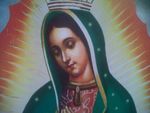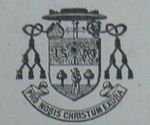THE ROSEAU CATHEDRAL: the sanctuary and - nave before Vatican II. by Bernard Lauwyck
←
→
Page content transcription
If your browser does not render page correctly, please read the page content below
THE ROSEAU CATHEDRAL: the sanctuary and nave before Vatican II. by Bernard Lauwyck In the previous articles we studied the cathedral sanctuary of 1905 and 1924. In this article , we will study a photograph taken before the iconoclasm period after the Second Vatican Council (1962-1965). Iconoclasm is the deliberate destruction or removal of religious images, statues, symbols and is usually part of major religious changes. Vatican II caused major changes in the ages old liturgies. Centuries before the protestant iconoclast movement in the 16 th Century, St. Bernard of Clairvaux (1090 -1153) expressed his immaterial beliefs and his disappointment with Abbot Suger’s beautiful Gothic cathedral in St. Denis, France: “There is more admiration for beauty than veneration for sanctity. Thus churches are decorated, not simply with jeweled crowns, but with jeweled wheels illuminated as much by their precious stones as by their lamps. We see candelabra like big bronze trees, marvelously wrought, their gems glowing no less than their flames. Vanity of vanities! The church is resplendent in her walls and wanting in her poor. She dresses her stones in gold and lets her sons go naked. ” Powerful stuff, but still we are God’s people living in a material world. Our God- given 5 senses allow us to communicate with the world around us, only by what we can feel, taste, smell, see and hear. How can we perceive the wonder of creation, the splendor of the Lord? Only through our 5 senses! Through beauty we can perceive the reality of God. This is how Pope Benedict XVI defends the truth of Christianity: “The proof of God Is Beauty.” This is in my view the beauty in liturgy, art, architecture, music and human relations. The Catechism of the Catholic Church teaches us that “the love of beauty” is caught up in the glory of the living and true God. Now we know this, we look at the pre-Vatican cathedral in which grandiose ceremonies took place.
In this photograph, we can see both the nave and the sanctuary. This provides us
with three important elements of architectural and interior design namely the
ceiling, wall and floor decorations or finishes of the pre-Vatican II cathedral.
But first let us notice the items which were already present in the 1924 sanctuary:
The white metal railing
The Cathedra or Bishop’s Throne, of
which, to date I do not have a decent
picture to show you.
The white marble High Altar with the 7 bronze statuettes and tabernacle.
The
chandelier with candles, which can be observed in detail on this photo.
The “bright” stained glass windows in the sanctuary, providing a lot of light
in the sanctuary
The fixed choir stalls, seating for priests in the sanctuaryNotice also, to the left, the statue of St. Joseph with the white lily and child Jesus.
This statue was installed and blessed in 1910. On the right the triptych or 3 parts-
panel of Our Lady of Perpetual Succour, which was installed in 1921.
Let us start with the flooring :
I have taken the time and made the effort to document these old tiles as they may
be lost forever. Some were hidden under the blue wall-to-wall carpet. I want you to
remember that in church architecture each element has meaning and function. We
all know the function of a floor.
We start with the small square and triangular mosaic tiles in the processional aisle,
on which we all have walked so many times so that we do not see the beauty of
this flooring any more.
At first I thought it had a
classical geometric tile pattern
of the Edwardian and Victorian
periods with, among others
patterns, a classic dogtooth
black and white border.
dog tooth black and whiteBut then I noticed the 8 pointed star pattern. Eight pointed stars are associated with the Virgin Mary and is the Regeneration Star. Jews were circumcised on the eight day after their birth. Circumcision is the initiation ritual in Judaism. As baptism is the initiation into the Church, the Body of Christ, many baptismal fonts have eight sides and are shaped as an octagon. Jesus Christ was resurrected on the eight day. The eight pointed stars on images of Our Lady. We are not sure when these mosaic colourful tiles in the processional and communion space, with an area of 1576 sq. Ft, were installed. In the 1905 photograph we noticed that, at that time, there was timber flooring. I suppose that they were installed by God’s architect Brother Xavier Lecointe C.Ss.R. during the 1907-1910 renovation works. These types of tiles are called “Encaustic tiles” and are ceramic tiles in which the pattern or figure on the surface is not a product of the glaze but of different colours of clay. They may be composed of as many as six different colours. The pattern is inlaid into the body of the tile, so that the design remains as the tile is worn down. Encaustic tiles may be glazed or unglazed and the inlay may be as shallow as an eighth of an inch, as is often the case with "printed" encaustic tile as deep as a quarter inch. Encaustic or inlaid tiles enjoyed two periods of great popularity. The first came in the thirteenth century and lasted until Henry VIII's reformation in the sixteenth century. The second came when the tiles caught the attention of craftsmen during the Gothic Revival Period in churches, the period the Roseau Cathedral was built and decorated. The centre of tile production was in England.
The other tiles are also encaustic tiles, look like mosaic but are regular square tiles. They can be found in small quantities in the sanctuary and the side chapels : The beautiful tiles below can be found in the present Blessed Sacrament chapel: In the area around the altars: Again the eight pointed star
And the last element I want to comment on is the curved ceiling,
I am informed that the sanctuary ceiling was blue and had shining stars, reminding
us of the heavens . It must have looked like this picture :
A ceiling provides heat insulation and sound proofing. A church without ceiling is
hot. When heavy rains fall it can be very noisy.
But our studies have shown that this Cathedral ceiling plays a major role in the
acoustics of this place of worship.
Architectural acoustics as an engineering discipline is a relatively new field,
emerging in the early twentieth century. When such an expert from Arup Acoustics
UK visited our cathedral, he was astonished and amazed how good the acoustics
were. “The old guys really knew what they were doing” . The curved ceiling
ending in a half dome above the High Altar served all the needs of a church
building without sound system. The sound board above the pulpit was very
effective.
In our renovation works we have to make sure that we maintain three very
important elements so that this good acoustic quality of the building is preserved:
The shape of the ceiling has to be copied meticulously.
The sturdiness of the ceiling, which is a result of the density of the boards
and the spacing of the ceiling joist, is very important.
The un-even surface of the boards has to be imitated.
The timber flooring, under the pews, worked together with the timber ceiling to
provide an excellent acoustics. A sound system has to be purchased, recommended
by Arup Acoustics, for amplification of the spoken word. This will entail small
rectangular speakers, located about 8 feet above the floor. A study has to be made
for the amplification of music as the Cathedral was designed for natural acoustics.
Old hymns, according to Mr. Cedric Phillip, allow for the resonance of a natural
acoustical setting. Modern instruments and music however does not. Also Carpet
in the sanctuary is a NO-NO where good acoustics is concerned.
It was further revealed that the Debierre organ is an excellent organ, but fabricatedfor a chapel. Its capacity cannot be increased. So as we want to preserve the beautiful acoustics of our Roseau cathedral, we have our work cut out for us. This concludes our description of the pre-Vatican II cathedral. bernardlauw@yahoo.com PO Box 317 Roseau Dominica
You can also read



























































